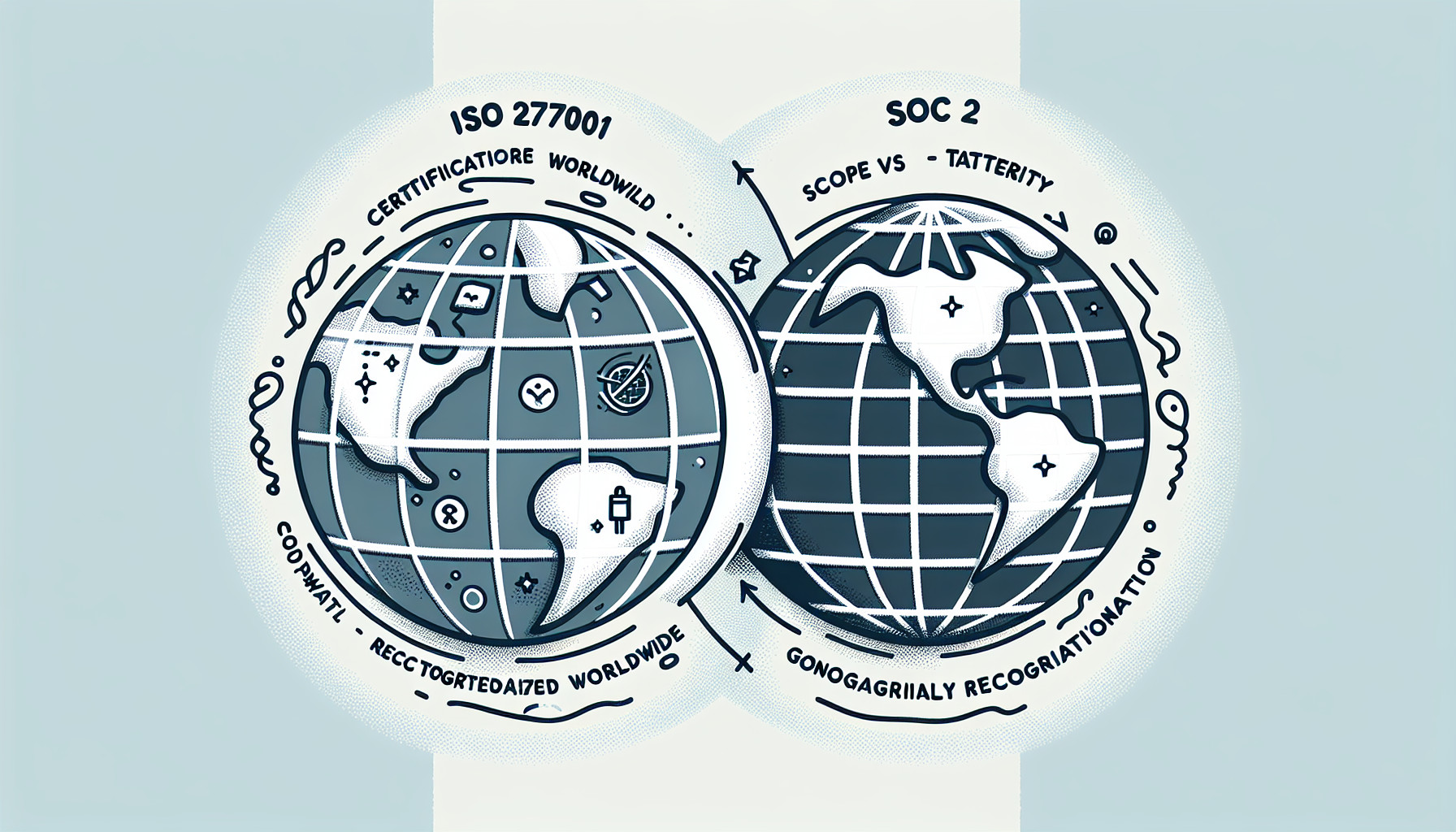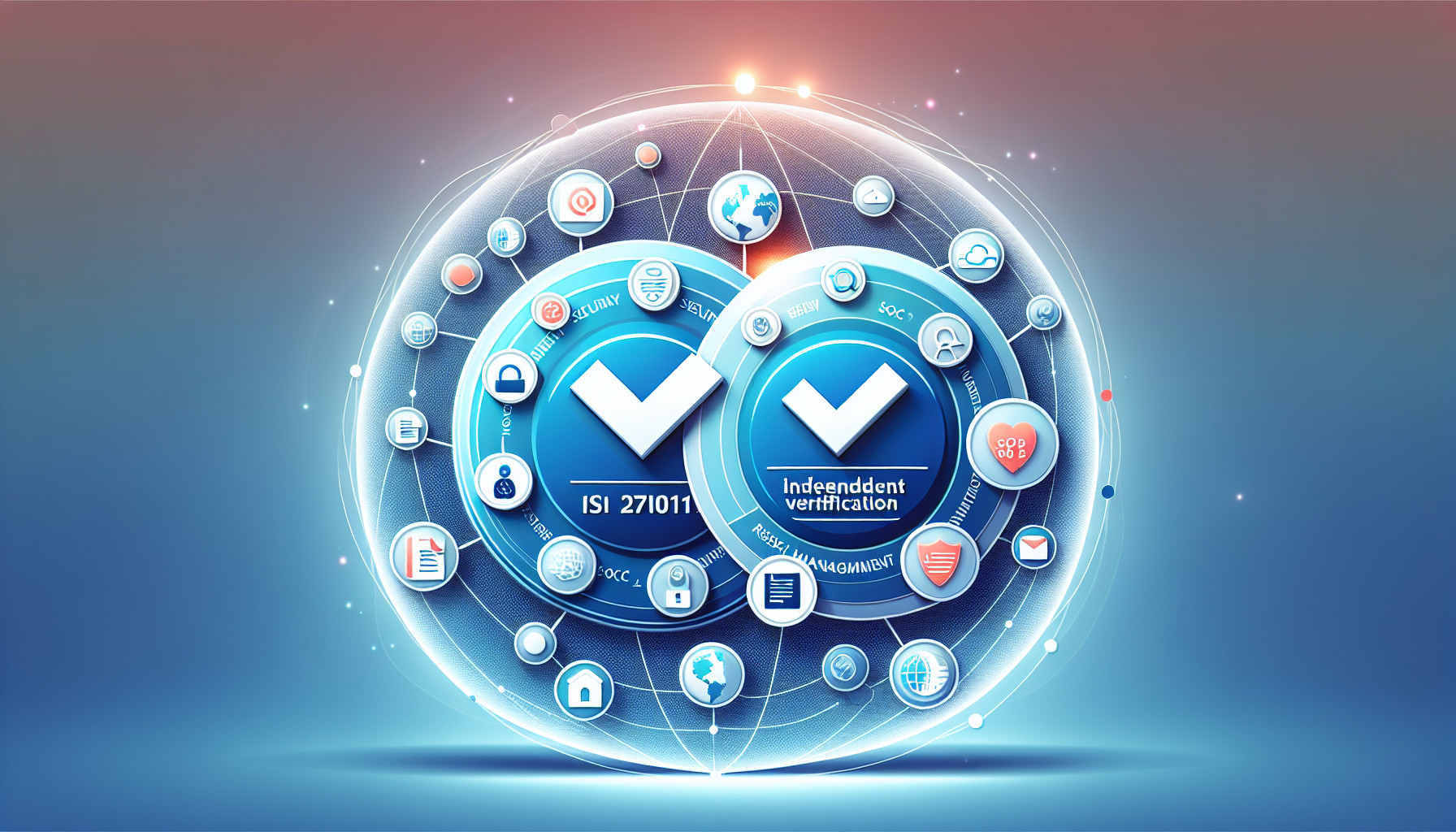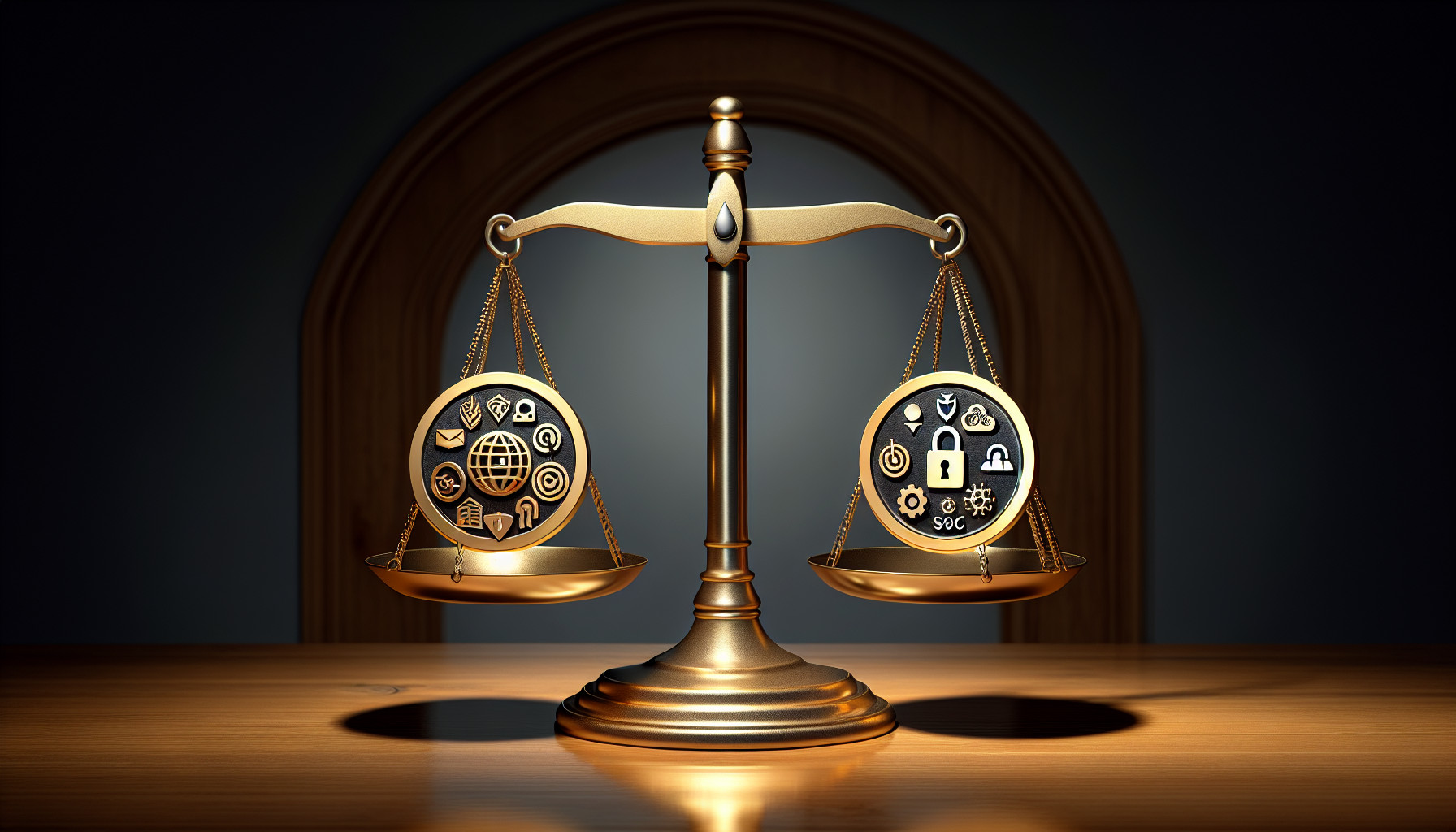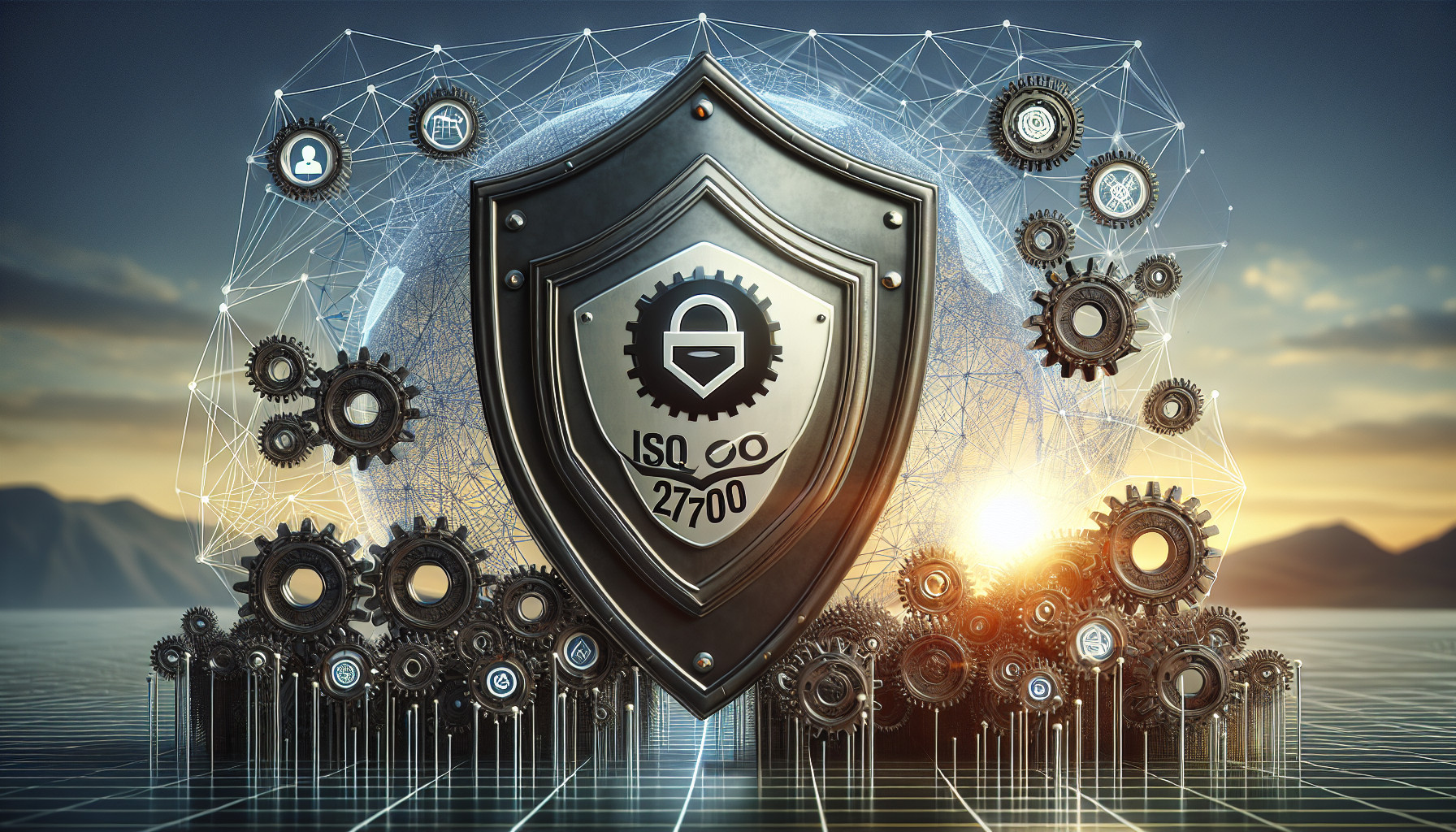
In the debate of iso 27001 versus soc 2, choosing the right framework can fortify your company’s data security. ISO 27001 spans international boundaries with a certification for comprehensive security management, while SOC 2 focuses on specific trust principles in a U.S. context.
This post hones in on the critical contrast points, helping you navigate which standard best aligns with your organization’s requirements.
Key Findings
-
ISO 27001 is a comprehensive international standard for Information Security Management Systems, whereas SOC 2 is a U.S.-based standard focused on evaluating security controls for customer data protection, with each serving different geographical preferences and industry applications.
-
While ISO 27001 requires a more extensive audit and implementation process, SOC 2 offers more flexibility by allowing organizations to tailor controls to their operations, with both standards having roughly 80% overlap in their security controls and requirements.
-
Organizations benefit from implementing both ISO 27001 and SOC 2 by exhibiting a strong commitment to information security across various regions and industries, thereby enhancing their security posture and complying with a wide range of stakeholder expectations.
Understanding ISO 27001 and SOC 2

Organizations frequently utilize ISO 27001 and SOC 2 to evaluate and fortify their security posture in line with recognized best practices and industry standards, such as design and operating effectiveness.
Both involve principal domains of information security, encompassing confidentiality, availability, and integrity protect customer data, helping organizations achieve compliance with industry standards. This ensures robust data management through a systematic approach, a key component in both ISO 27001 and SOC 2.
ISO 27001 is an internationally acknowledged standard designed for the implementation of an Information Security Management System (ISMS) to safeguard sensitive information. On the other hand, SOC 2 is a standard developed by AICPA in the United States for service organizations, with a primary focus on assessing the effectiveness of service organization control and security controls in protecting customer data.
What is ISO 27001?
ISO 27001 is a widely acknowledged standard designed for the implementation of an Information Security Management System (ISMS) aimed at safeguarding sensitive information for international organizations. Certification with ISO 27001 enables organizations to:
the confidentiality, integrity, and availability of essential data
-
Offer third-party reassurance to clients
-
Minimize information security risks
-
Introduce stringent measures to data management through the implementation of security controls.
The certification process for ISO 27001 involves a substantial time commitment, third-party audits to validate adherence to standards, and the fulfillment of rigorous criteria, including a thorough risk assessment. Organizations that achieve certification are required to comply with the seven primary requirements outlined in the framework.
Although ISO 27001 is acknowledged worldwide, it is predominantly requested by international clients, with a specific focus on Europe, as it provides the same security controls across all industries, including those within an international organization.
What is SOC 2?
SOC 2 Compliance is a voluntary compliance standard established by the American Institute of Certified Public Accountants (AICPA), with a focus on evaluating an organization’s security controls for safeguarding customer data. It is instrumental in ensuring the privacy of both the organization and its clients, emphasizing the need for effective controls tailored to their operations.
The verification of SOC 2 compliance is achieved through an auditing process. An organization enlists an external auditor to evaluate its security program and internal controls based on chosen Trust Services Criteria (TSC). The Trust Service Principles (TSP) in SOC 2 encompass:

- Security
- Availability
- Processing Integrity
- Confidentiality
- Privacy
These criteria are set by AICPA to define SOC 2 compliance journeys.
SOC 2 compliance benefits include:
- Assurance to customers about the existence of stringent controls to protect their data
- Building trust with customers
- Attracting privacy-conscious customers
These benefits arise from the attestation report that details the controls in place.
Key Differences Between ISO 27001 and SOC 2

While both ISO 27001 and SOC 2 are integral to a strong information security management system, they differ in significant ways. Here are the key differences:
- ISO 27001 is a recognized international security certification standard, while SOC 2 comprises audit reports conducted by an independent Certified Public Accountant (CPA) or accountancy organization leading to an attestation, based on the five trust services criteria.
- ISO 27001 audits encompass a wider scope and necessitate more comprehensive compliance measures compared to SOC 2.
- The audit duration for SOC 2 is generally shorter, requiring less time for completion in contrast to ISO 27001.
- ISO 27001 also imposes specific assessor requirements and focuses on operating effectiveness.
In fact, SOC 2 compliance provides more adaptability and personalization than ISO 27001, since the latter comprises standard requirements that are directive and applicable universally across all sectors. Geographically, SOC 2 is predominantly acknowledged as the prevailing compliance standard in North America, while ISO 27001 enjoys broader international recognition.
Similarities and Overlap Between ISO 27001 and SOC 2

Despite their differences, ISO 27001 and SOC 2 share core similarities. Both place emphasis on information security practices, with ISO 27001 highlighting a holistic approach and SOC 2 concentrating on controls associated with service providers. They place emphasis on risk management and independent verification to guarantee that controls are proficiently addressing information security risks.
Moreover, there is a significant overlap between the two frameworks. ISO 27001 and SOC 2 exhibit numerous overlapping controls and requirements, with an estimated 80% convergence as per the ISO 27001 vs SOC 2 mapping spreadsheet published by the AICPA.
Factors to Consider When Choosing Between ISO 27001 and SOC 2

When deciding between ISO 27001 and SOC 2, several factors should be considered:
- The target market
- Customer requirements
- Security posture
- The compliance landscape specific to the industry
ISO 27001 certification is widely accepted by many companies in the United States, and numerous companies situated outside of the United States are willing to accept a SOC 2 report.
Ultimately, the choice between these two frameworks should be guided by the unique needs and goals of your organization.
Both ISO 27001 and SOC 2 possess their unique advantages, and the selection should depend on which standard can most effectively assist your organization in realizing its information security and business continuity goals.
Benefits of Implementing Both ISO 27001 Information Security Management System and SOC 2

Adopting both SOC 2 and ISO 27001 can yield multiple benefits. The integration of both standards enhances the safety of the information security management system, offering a more comprehensive strategy for managing and safeguarding sensitive data.
Acquiring both ISO 27001 and SOC 2 certifications allows organizations to exhibit adherence to a wider array of stakeholders across various regions and industries, potentially expanding their business prospects.
Moreover, the implementation of both ISO 27001 and SOC 2 can contribute to streamlining an organization’s compliance process by leveraging the overlapping controls and requirements, thereby facilitating the efficient attainment and maintenance of multiple certifications.
An organization should consider choosing both ISO 27001 and SOC 2 in order to significantly enhance their cybersecurity posture and offer robust assurances to their customers concerning data management and information security threats.
Navigating the Certification and Compliance Processes
A methodical approach is crucial for maneuvering through the certification and compliance processes for ISO 27001 and SOC 2. This includes conducting a comprehensive gap analysis, implementing necessary controls, and undergoing an external auditing process.
The process of conducting a gap analysis for ISO 27001 and SOC 2 involves a comprehensive review and external audit of the organization’s current information security posture in comparison to the requirements of the respective standards.
The procedures involved in the ISO 27001 certification process encompass preparation, establishment of context, scope, and objectives, establishment of a management framework, and development and implementation of an ISMS that complies with the requirements of the Standard.
For SOC 2, the steps involved include identifying the scope, conducting a surveillance audit, gap analysis and control mapping, and external reporting, among others.
External auditing plays a vital role in the entire process:
- Assessing the existing security controls
- Ensuring adherence to the relevant standards
- Significantly contributing to the certification and compliance procedures for ISO 27001 and SOC 2.
Building a Robust Information Security Strategy with ISO 27001 and SOC 2 security controls
Constructing a solid information security strategy with ISO 27001 and SOC 2 guarantees ongoing enhancement, congruence with business objectives, and bolstered trust among stakeholders. The fundamental components of developing a strong information security strategy with ISO 27001 involve risk management, access control, network and web-based security, data backup and recovery, physical security, employee training and education, and monitoring and review.
In the case of SOC 2, it is essential to establish policies that uphold its five trust service criteria: security, availability, processing integrity, confidentiality, and privacy, as well as regulate the organization’s technology, processes, and personnel.
Continuous improvement of security criteria is a fundamental aspect of an information security strategy employing ISO 27001 and SOC 2. This entails frequent assessments of controls, policies, and procedures to pinpoint areas for enhancement, ultimately leading to measures to strengthen security protocols.
A strategy for information security aligned with ISO 27001 and SOC 2 can be integrated with business objectives by first identifying the various security objectives and then implementing security controls customized to meet them, thereby ensuring that the security measures directly contribute to the overall goals and directives of the business.
Adhering to ISO 27001 and SOC 2 standards through the implementation of an information security strategy contributes to:
- Building trust with stakeholders by showcasing dedication to strong information security
- Elevating the organizational brand value
- Instilling confidence among vendors and other business partners.
How Cyphere help customers build security strategy and compliance in one?
Cyphere tailors its Cyber Security Services to accommodate the unique needs of each organization by providing:

- Customized cyber security audit services that are specifically tailored to the company’s requirements and challenges
- Formulating security policies
- Deploying round-the-clock monitoring using technology solutions, including vulnerability scanning and dark web scanning
- Implementing a comprehensive security strategy
While specific details regarding these services are not disclosed, it’s clear that Cyphere provides a variety of services aimed at assisting in the attainment of compliance with ISO 27001 and SOC 2.
Seeking Professional Guidance for Data Security Compliance
In the intricate realm of data and information security compliance, expert advice can help in:
- Customizing security solutions to the organization’s distinct needs
- Ensuring risks are promptly recognized and managed
- Assisting organizations in aligning IT security compliance with their business objectives
- Improving data management capabilities
- Mitigating the risk of fines and penalties
Professional guidance can provide valuable assistance in these areas.
Collaborating with a vendor and technology agnostic cyber security company, such as Cyphere, guarantees that organizations receive impartial advice and tailored recommendations that are specific to their environment, free from any commercial bias towards particular products or solutions.
A reliable cyber security partner plays a crucial role in assessing cyber risks, enhancing operational security, consistently identifying and addressing risks, and offering insights into potential threats.
Additional Resources and Support
Additional resources and support, such as a complimentary consultation session with the Cyphere team, can aid businesses in understanding the complexities of data security compliance and making knowledge-based decisions.
Engaging in a consultation session with the Cyphere team regarding data security compliance can result in improved security stance, compliance with regulations, and protection against data breaches and cyber attacks.
Businesses can anticipate engaging in discussions to explore ideas or to deliberate on the optimal approach for financing a significant acquisition during a complimentary consultation session with Cyphere.
Summary
In conclusion, ISO 27001 and SOC 2 are powerful tools that can help organizations strengthen their security posture and manage information security risks. Their differences and similarities offer a flexible approach to data security, allowing organizations to choose the best path according to their specific needs.
Implementing both standards can provide a more comprehensive strategy for managing and safeguarding sensitive data, demonstrating adherence to a wider array of stakeholders, and streamlining the compliance process.
Ultimately, the choice between these two frameworks should be guided by the unique needs and goals of your organization, and professional guidance can be invaluable in navigating this complex landscape.
Frequently Asked Questions
How is ISO 27001 different from SOC 2?
ISO 27001 is more widely accepted internationally compared to SOC 2, and it generally requires more time and cost to complete. A licensed CPA firm attests SOC 2, while a recognized ISO 27001-accredited registrar certifies ISO 27001.
Is ISO 27001 the same as soc1?
No, ISO 27001 and SOC1 are not the same. ISO 27001 is internationally recognized and requires proof of an operational ISMS, while SOC1 enables the operating effectiveness of controls to be tested over a period of time.
Is SOC 2 a certification or accreditation?
No, SOC 2 is not a certification or accreditation. Instead, it results in a formal attestation rather than a certificate.
What are the similarities between ISO 27001 and SOC 2?
Both ISO 27001 and SOC 2 emphasize information security and risk management, and have overlapping controls and requirements, with an estimated 80% convergence (AICPA).
How does Cyphere help customers build a robust security strategy and achieve compliance with both ISO 27001 and SOC 2?
Cyphere helps customers build a robust security strategy and achieve compliance with ISO 27001 and SOC 2 by tailoring their cyber security services to each organization’s unique needs, implementing security policies, using compliance automation platform and deploying 24/7 monitoring technology solutions.
Harman Singh is a security professional with over 15 years of consulting experience in both public and private sectors.
As the Managing Consultant at Cyphere, he provides cyber security services to retailers, fintech companies, SaaS providers, housing and social care, construction and more. Harman specialises in technical risk assessments, penetration testing and security strategy.
He regularly speaks at industry events, has been a trainer at prestigious conferences such as Black Hat and shares his expertise on topics such as ‘less is more’ when it comes to cybersecurity. He is a strong advocate for ensuring cyber security as an enabler for business growth.
In addition to his consultancy work, Harman is an active blogger and author who has written articles for Infosecurity Magazine, VentureBeat and other websites.












